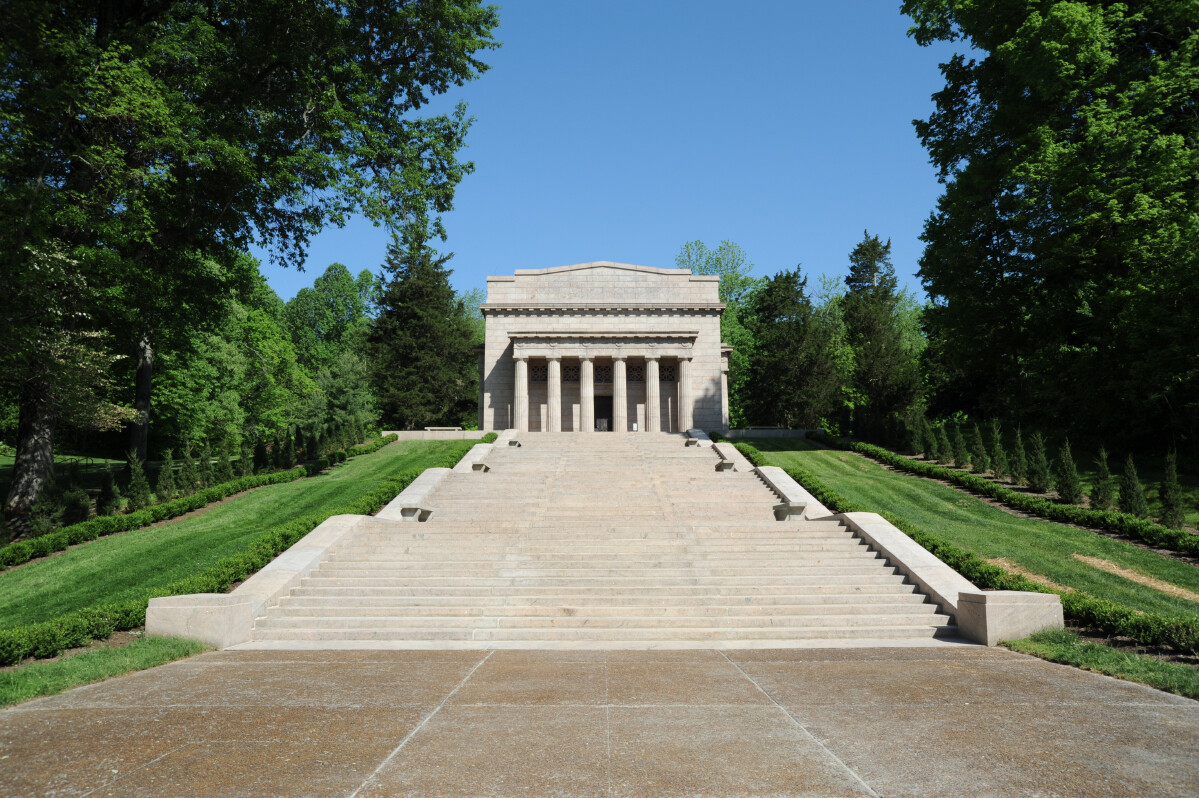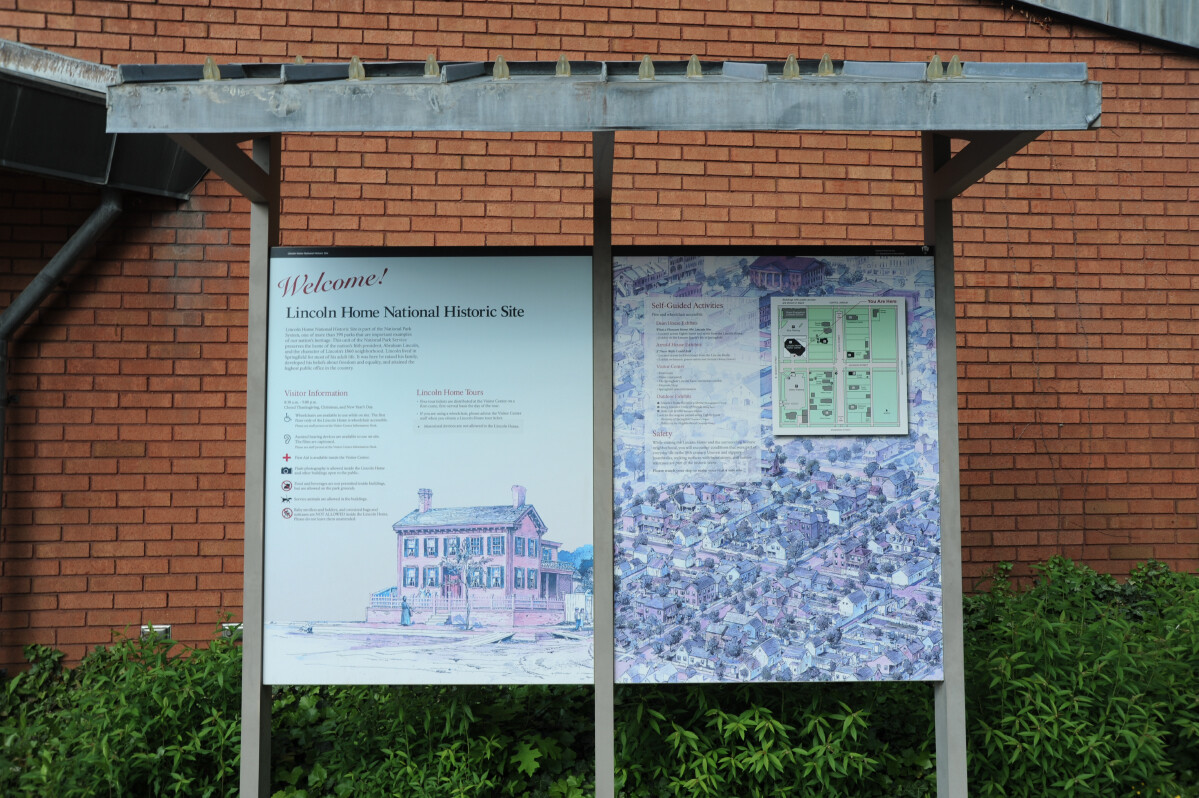
The site where Abraham Lincoln was born in 1809 is now a National Historical Park in Hodgenville, Kentucky, fifty miles south of Louisville.

The 348-acre farm was purchased by his father in 1808, for $200. It was called the Sinking Spring Farm, and his father built a cabin next to the spring. Lincoln was born in that cabin the following year.

Today there is a visitor center with displays about the president.

The main feature is a memorial with 56 steps, one for each year of the president’s life, built on the location of his original birthplace cabin.

Inside the structure is his birthplace cabin - which, however, is not really the actual birthplace log cabin.

Though not the original one, the cabin’s journey to this site is an odyssey worthy of a lavish classical shrine.

The Lincoln family moved to another farm two years after he was born, and it is likely that the original log cabin was burned up for firewood by subsequent owners, probably in the 1830s. Another log structure was built on the site, and later moved and reused elsewhere.

By the 1860s, with Lincoln in the White House, and the Civil War raging, the importance of this historic president’s birthplace and cabin was attracting interest.

Federal efforts to acquire the birthplace faltered, and in 1894, it was bought by a New York restaurant chain owner and missionary, Alfred Dennett, who had plans to develop it into a tourist attraction.

Dennett acquired a cabin that locals claimed was the original cabin, removed from the site years ago. He also purchased the alleged birthplace cabin of Confederate President Jefferson Davis, then took the two cabins on the road, showing them side by side at fairs and expositions, assembling and disassembling them over and over.

By 1904, Dennett was in financial ruin, and committed to an insane asylum. The birthplace was auctioned off in 1905, and purchased by the publisher of Collier’s Weekly, with the intent of preserving it and opening it to the public, in a proper way.

The birthplace cabin, pieces of which by then were mixed up with Jefferson Davis’ cabin, consisted of around 200 logs, a door, a window, and some floorboards, in storage in a basement in New York, after being displayed for the last time at Coney Island.

Collier’s group purchased it from its current owner, for $1,000, and the pieces were eventually transported back to the Kentucky birthplace, with much ceremony, draped in a flag, and people saluting as the procession passed from town to town.

Money was raised to commission the large neoclassical memorial, designed by the architect of the Thomas Jefferson Memorial, and a dedication was held at the beginning of construction, in 1909, on Lincoln’s 100th birthday, attended by President Theodore Roosevelt.

After the stone memorial building was completed, it was discovered that the cabin was too large for the space, so it was trimmed down from its original 16 by 18 feet, to 12 by 17 feet. At the end of construction, in 1911, another dedication was held, attended by President William Taft.

A third ceremony was held in 1916, when Collier’s group, known as the Lincoln Farm Association, turned it over to the Federal government, and it finally became Abraham Lincoln National Park. President Woodrow Wilson was there to accept it.

Later research officially challenged the authenticity of the logs that made up the reconstructed cabin, and in 1956 the Park Service was finally forced to admit that the cabin was of “debatable authenticity.” Eventually the logs were scientifically tested, and they dated to the 1850s, four decades later than Lincoln’s birth.

The Lincoln family left the cabin when he was two years old, and moved to Knob Creek Farm, ten miles east, where they lived for five years.

This location is also owned and operated by the National Park Service.

There is a replica of the log cabin they lived in at this location, built in 1931, using logs from a nearby cabin.

There is also a log cabin style ranger station, originally constructed in 1933 as the Lincoln Tavern, a watering hole built to attract tourists who were increasingly traveling to the area to visit Lincoln-related sites.

In 1816, the Lincoln family moved again, to a farm in Indiana, near Lincoln City (though it wasn’t called that then). This site is now the Lincoln Boyhood National Memorial, and is also operated by the National Park Service.

The Lincoln family lived there until 1830, so this is where Abraham spent most of his youth, from age seven to 21.

A large memorial building was constructed by the state in the early 1940s, and the park areas were landscaped by Frederick Law Olmsted Jr.

Inside are displays about Lincoln, and his time in Indiana.

His mother passed away when Lincoln was nine, and is buried here. His father remarried.

In the 1930s, the site of the original cabin they lived in was discovered, with some degree of certainty; however, the decision was made to not make a reconstruction.

Instead, a ruined fireplace and sill beams outlining the walls were cast in bronze and set on the ground, inside a walled perimeter.

The Boyhood Memorial site includes a living history park, with actors dressed in period attire performing period activities in reconstructed period buildings.

After a few years in various jobs, including working as a surveyor, postmaster, and a clerk in a general store in New Salem, Illinois, Lincoln moved to Springfield, Illinois, to practice law. This town, the state capitol, would be his hometown for the rest of his life.

The Lincoln Home National Historic Site is a four-block area in the middle of town which has been taken over by the National Park Service, which is restoring the neighborhood around the house he lived in for most of his time in Springfield.




Abraham Lincoln purchased the house here in 1844, and it was the only house he ever owned.

The house was expanded over the years as his family grew.

He was living here in 1860, when a delegation of Republicans came to his door to tell him he had been nominated as their candidate to run for the presidency.

He campaigned mostly without leaving town.

In February, 1861, after winning the election, he left Springfield for Washington, and the Civil War, expecting to return.

He did return, in 1865, though as a memory, a legend, and a corpse.


After his assassination in Ford’s Theater in Washington, the president’s body was displayed in the capitol, before embarking on a three week tour, by train, with many memorials and services in cities along the way, and back to Springfield, where it was placed in a temporary vault at Oak Ridge Cemetery, until the main tomb was ready.

Six years later, he was moved to the still unfinished monumental tomb, which, three years after that, was complete, and was dedicated by President Ulysses S. Grant.

Inside, somber statues and corridors lead to the sarcophagus.


